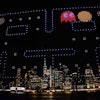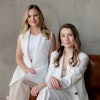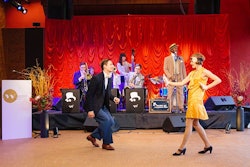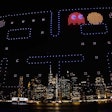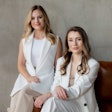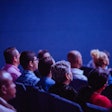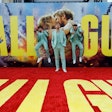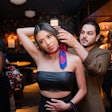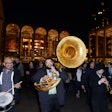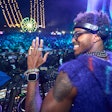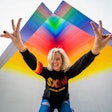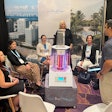The frenetic pace of Fashion Week in New York is nothing new, but this season the biannual event seemed even busier, with attendees running to and from venues uptown, downtown, and everywhere in between.
Held September 10 to 17, the IMG-owned event now known as New York Fashion Week: The Shows, moved from its somewhat centralized location at Lincoln Center to a trio of spaces—Milk Studios, Skylight Clarkson Square, and Skylight at Moynihan Station. And despite the Council of Fashion Designers of America's efforts to align the shows properly based on the Fashion Calendar, which it owns, designers appeared to abandon any sense of cooperation, scattering their showings across the city, with the majority concentrated downtown and along the West Side Highway.
The official venues also saw some growing pains. Although the Skylight properties were refreshingly free of the avalanche of marketing showgoers are accustomed to being bombarded with, the lack of Wi-Fi and shuttle buses between them didn’t win over any new fans. (IMG has confirmed that both Skylight Moynihan Station and Clarkson Square will return as official New York Fashion Week venues come February.)
However, with every major designer seemingly showing at his or her own unique venue, this season may have proved Fashion Week's most creative yet—at least in terms of event production.From Marc Jacobs and Opening Ceremony to Coach and a spectacular Givenchy, the New York shows had never been more aligned with their European counterparts when it comes to imagination. And that was a good thing.
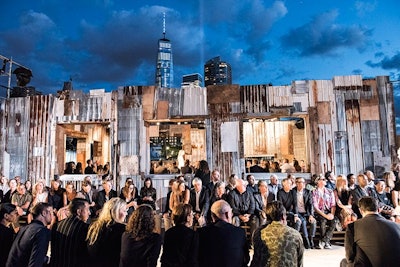
Givenchy, in celebrating its first-ever Manhattan flagship, staged a one-off show that was a powerful tribute to New York City on September 11. The riverside setting, on Pier 26 in TriBeCa, allowed for an unobstructed view of the Freedom Tower from every seat. Produced by Laprod, the event took more than six months to produce and the guest list numbered around 4,000.
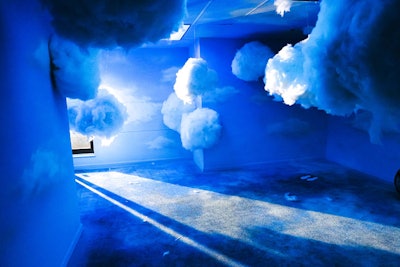
To celebrate its 10th anniversary, Refinery29 hosted a bash in the Greenpoint neighborhood of Brooklyn on September 10 that featured immersive spaces showcasing fashion, art, performance virtual reality, film, and music. "29Rooms" was produced in partnership with the Gathery, the creative services company led by Nicky Balestrieri and Luigi Tadini. One space, "Sound in the Clouds," invited guests to pop their heads inside physical clouds and listen to music curated by Saint Heron, the new movement under Solange's label, Saint Records.
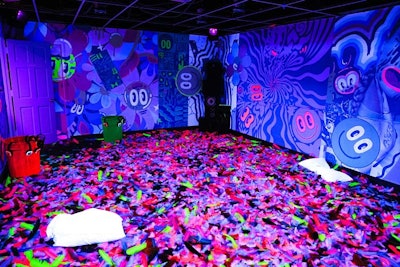
"Art in the Dark" featured the work of London-based "professional doodler" Hattie Stewart, who designed a physical experience for guests to dance through black lights and a silent disco with music curated by the global music and entertainment platform Tidal. The room encouraged visitors to let go of their inhibitions.
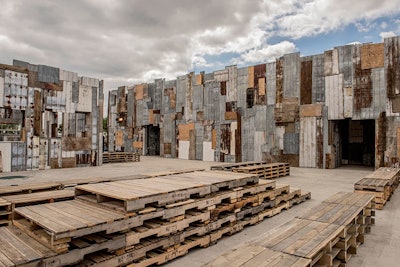
A multisensory experience orchestrated by artist Marina Abramovic greeted guests at sundown. The wooden and scrap metal set was constructed solely of recycled materials with performance artists suspended on platforms against the skyline, as was a monk, whose live chanting set the preshow mood.
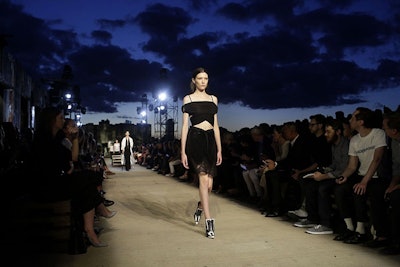
A gong signaled the start of the 88-look show. As part of his goal to be inclusive—and also marking his 10th anniversary at the house—Riccardo Tisci invited 1,200 fans and fashion students to the extravaganza. As the models took their final walk, a haunting version of "Ave Maria" rang out moments before the Givenchy creative director took his bow.
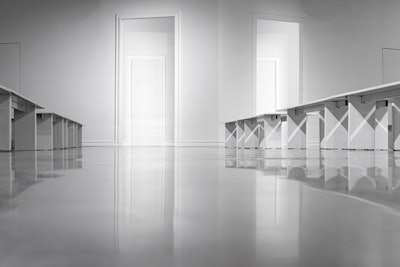
Produced by Bureau Betak, the September 11 Jason Wu show was set in an all-white venue at Spring Studios. Models emerged from behind two oversize door arches in a setting that was residential-meets-spacecraft. The dramatically stark backdrop was a theme that carried forth at two of Bureau Betak's other clients: Michael Kors and Diane von Furstenberg.
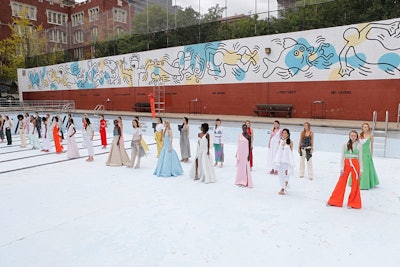
Held on September 11 at the Tony Dapolito Recreation Center, the Rosie Assoulin show saw models in their oversize, colorful wares on display in the venue's vast emptied-out pool. The on-site graffiti-esque mural complemented the whimsical nature of the garments.
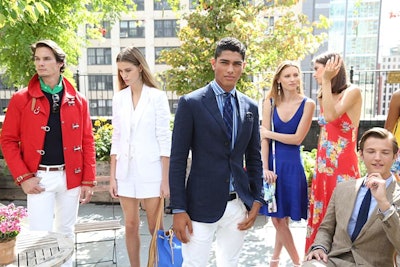
Ralph Lauren sought an outdoor venue for his September 11 women's spring Polo presentation, opting for the charm and grit of the outdoor Gallow Green venue high atop the McKittrick Hotel.
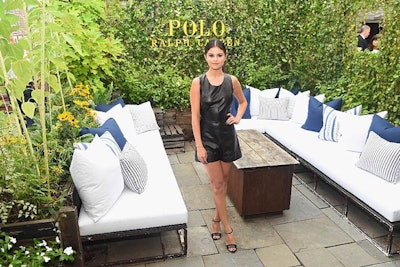
Selena Gomez (pictured) and Brooklyn Beckham were among the V.I.P.s at the daytime presentation. For the occasion, the Polo team transformed the outdoor gardens into a Ralph Lauren-theme setting, complete with signage and custom furniture. Gomez's Instagram from the presentation, as it turns out, was New York Fashion Week's most liked image.
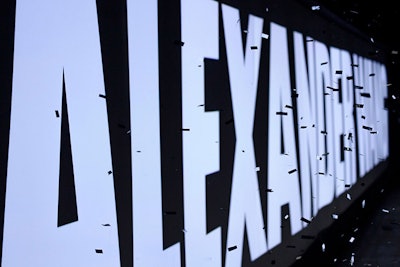
Alexander Wang celebrated the 10th anniversary of his namesake brand with a blowout fashion show and after-party at Pier 94. The show was a party from the first look, with models streaming out against a gigantic LED screen that played a retrospective video of both his humble beginning and designer achievements. At the end, Wang tore down the runway, signaling the start of the after-party.
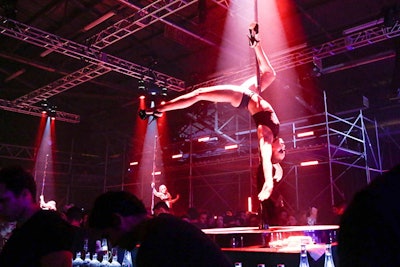
Professional female pole dancers were strewn throughout the cavernous pier space, helping to create the gritty, no-fuss, no-muss vibe that has become the Alexander Wang mantra.
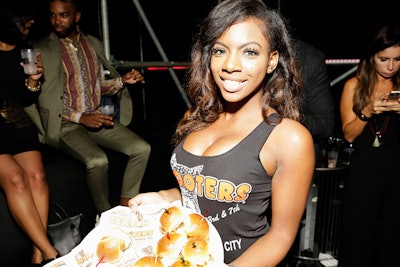
In lieu of fancy catering and gourmet food, waitresses from Hooters, along with the greasy and fast-food options they serve, were brought in to feed the hundreds of guests.
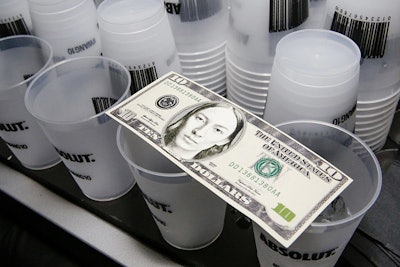
In addition to a special Evian water bottle designed by Alexander Wang that debuted at the after-party, the fun-loving designer also printed his own "stripper" bills and barcode drinking cups.
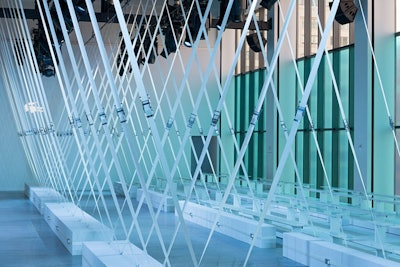
Following the exit by Mercedes-Benz Fashion Week from Lincoln Center, longtime Saturday calendar staple Lacoste decamped to Spring Studios for its September 12 morning show. Producer Bureau Betak devised a series of 150 parachute straps that ran a total length of 0.62 miles secured by 150 metal brackets. On the windows were 3,230 square feet of blue filters used to alter the venue's aesthetic.
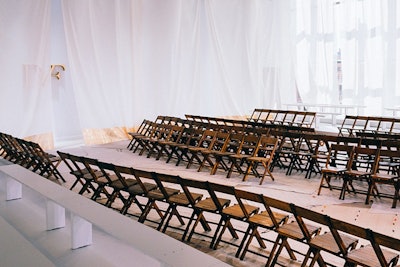
Eschewing the colorful backdrops employed in the past, Bureau Betak installed a decidedly pared-down set for Diane von Furstenberg's spring show at Spring Studios on September 13. Rows of simple folding chairs lined the runway, while 80 antique Turkish rugs, covering 7,534 square feet, were erratically strewn about. Adorning the backdrop were curtain veils reaching nearly 33 feet tall, the bottoms of which were trimmed in hand-applied gold leaf. Finally, 20 cinema fans were hung to add to the breezy setting.
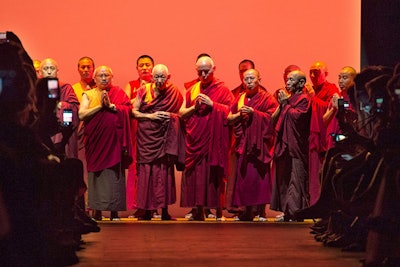
Prabal Gurung expressed gratitude to the fashion community and his devotion to his native Nepal (hit by a massive earthquake in April) by bringing out a group of robed monks prior to his September 13 show. The monks chanted a traditional prayer as the audience sat in silence at Skylight at Moynihan Station. After the monks made their exit, models took to the runway in dresses in a palette reminiscent of the Nepalese monks' robes.
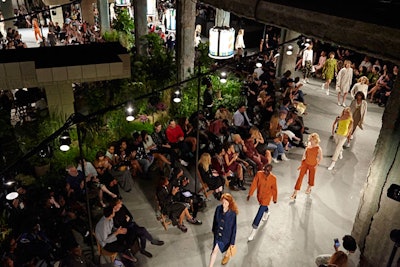
Inspired by Frank Lloyd Wright's visions of utopian gardens, the Opening Ceremony show on September 13 transformed 23 Wall Street into "The Living City," created in collaboration with the late architect's foundation and Edible Schoolyard NYC. Following the show, the plants were donated to four New York City public schools.
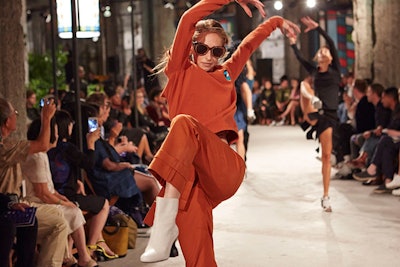
Much to the surprise of guests, models slipped, tripped, and went down, the performance part of a collaboration with New York City Ballet resident choreographer Justin Peck. The dancers were interspersed within the lineup of models, the idea of dance a conversation with the show's set.
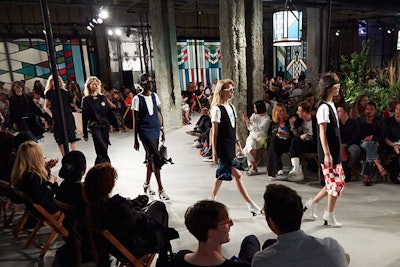
Designers Carol Lim and Humberto Leon channeled Frank Lloyd Wright's mid-century modern architecture via geometric stained-glass windows and gardens for the set—a live garden illuminated by mock stained-glass lamps.
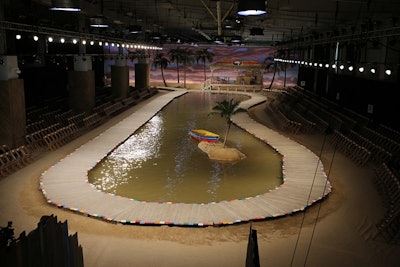
Caribbean vibes and island life a la Mustique, where Tommy Hilfiger has long vacationed, were largely on the designer's mind for his spring show, set at the Park Avenue Armory on September 14. Produced by KCD, the mini tropical escape featured a boardwalk-cum-runway circumscribing a lagoon, complete with its own beach-bar shack.
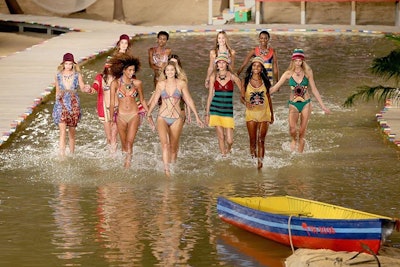
To end the show, Hilfiger took his audience on a joyous romp, led by model Gigi Hadid in a string bikini frolicking during the finale in a shallow pool of water.
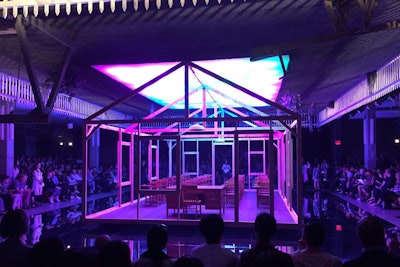
The September 14 spectacle at Skylight Modern was only something Thom Browne could bring about: a gallery space featuring a one-room schoolhouse in which the designer showed his interpretation of a Japanese schoolgirl's uniform. There were rows of chairs, a black notebook placed at each one, and a "teacher" dressed as a fully veiled Kabuki bride. On the side of the schoolhouse were a pair of men's feet, a la The Wizard of Oz.
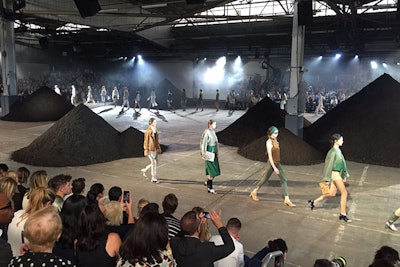
Guests arriving at the 10th anniversary 3.1 Phillip Lim show at Pier 92 on September 14 were met with massive soil sculptures curated by artist Maya Lin. The site-specific installation boasted seven towering mounds of nearly 200 tons of toxin-free compost in an artwork titled "Seven Earth Mountain." Models weaved between the mounds in the spring collection, aptly given the theme of "stop and smell the flowers." Following the show, 30 percent of the material was donated to the New York Restoration Project for local community gardens and others donated to the Perfect Earth Project.
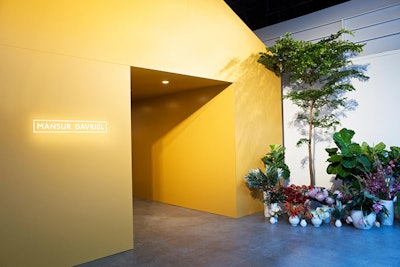
The chic September 14 presentation at the Swiss Institute of Contemporary Art showcased Mansur Gavriel's debut shoe collection, not to mention the label's coveted bags. Guests entered through a house setting that was erected inside the venue.
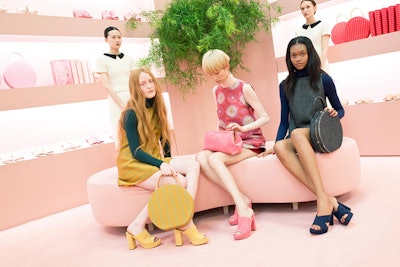
While the models sported shoes from the debut collection, the bags were displayed on custom shelves that ran the entire span of the bilevel space. The mod, Pepto-Bismol pink venue served as both a presentation and a Fashion Week respite with bar service.
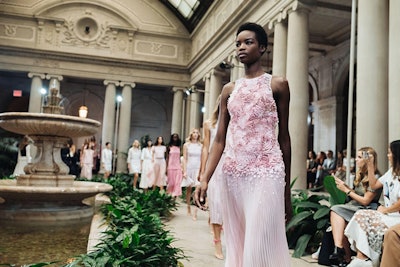
Having decamped from the main Fashion Week venues, Carolina Herrera presented her spring collection on September 14 at the historic Frick Collection on the Upper East Side. The Beaux-Arts grandeur of the covered courtyard offered a timeless backdrop for an equally timeless collection—and marked the first time the historic venue had hosted a fashion show.
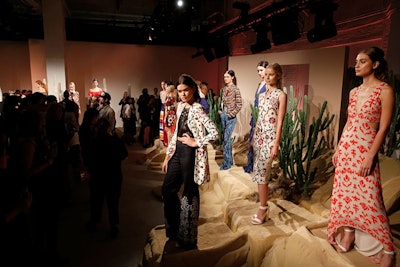
Stacey Bendet's September 15 Alice & Olivia presentation at Skylight Clarkson Square was set amidst a scene of an urban-inspired desert. Sand dunes, succulents, and looming boulders set the backdrop for a strong and vibrant collection that depicted, as was the theme, the woman as a goddess.
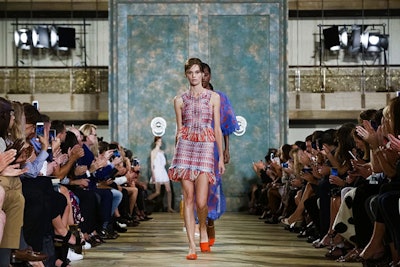
For her spring show on September 15, Tory Burch opted for her mainstay David H. Koch Theater at Lincoln Center as a venue that's been "enhanced through time and nature." Such would also explain the massive oxidized bronze door sculpture that served as the show's backdrop.
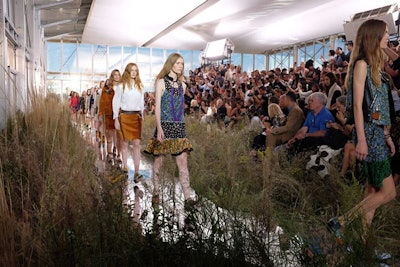
Coach looked to its backyard High Line Park as the setting for its first-ever runway show on September 15. Guests were ushered into a custom-built two-story greenhouse-like space that straddled the park and took two months to build. Inside, with a set fabricated by Creative NY and designed, along with the landscaping, by Stefan Beckman, models walked on a mirrored runway surrounded by tall grass.

Outside the venue, Coach wrapped a bevy of taxis in its signature prints as both a marketing gimmick and an instant social media photo op.
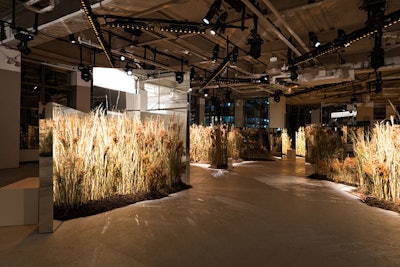
Following the show, Coach hosted a dinner at 225 Liberty Street in lower Manhattan. Produced by Bureau Betak, the cocktail portion featured mirrored panels 5 by 11.5 feet high complemented by tall grasses four feet high—the plant varieties of which were inspired by the original High Line.
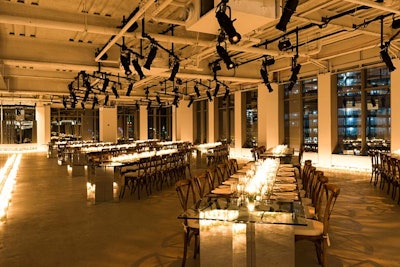
The Coach dinner featured a mirror wall that measured approximately 10 feet by 89 feet that ran along one side of the 3,230-square-foot venue. More than 2,000 candles in Mexican handblown glass votives dotted the tables, while 1,000 pieces of handmade ceramic were made for the event by an Argentine ceramist. Engraved leather placements featured the first name of each guest.
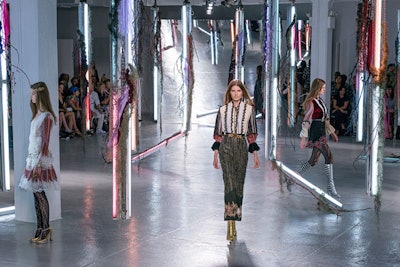
Mixed-media backdrops have become a mainstay at a Rodarte show, and for spring, the design sisters enlisted Bureau Betak to, once again, create a striking light show. The September 15 show at Center548 featured 17 poles made of cylindrical chicken wire—each pole comprising mirrored tape, painted natural branches, painted and natural Spanish moss, fishnet, colored wool roving, and artificial hair extensions. To provide contrast, color gels in three tones—anthracite, burgundy, and coal—were interspersed throughout.
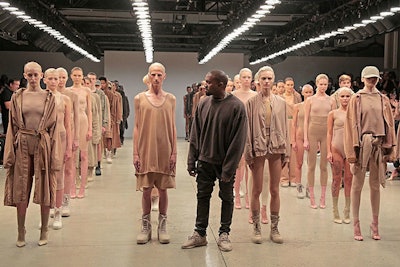
Kanye West's sophomore Yeezy 2 collection for Adidas threw the Fashion Week calendar into a tizzy—the unannounced show sprung up seemingly overnight. Held once again at Skylight Modern, the September 16 show featured a star-studded front row and a militaristic procession of nude bodysuits lit from above by four rows of harsh spotlights.
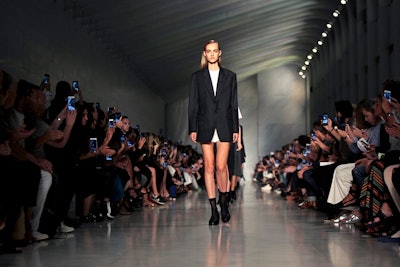
With new co-creative directors at the helm and Donna Karan firmly seated front row, the new chapter of DKNY made a powerful statement with its venue: the Westfield World Trade Center's West Gallery. The September 16 show took over much of the 600-foot underground walkway linking the World Trade Center with Brookfield Place, with models walking a 250-foot runway set up under a ceiling of marble, white-arched industrial pipes. It all made for a fitting homage to the brand's namesake hometown.
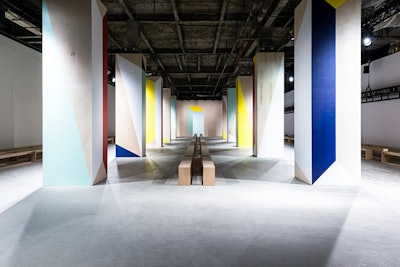
Jason Wu's striking spring show for Boss realized the Bauhaus influences of the garments in the set as well. The September 16 show high atop 245 Park Avenue featured 14 hand-painted birch wood columns measuring 19 feet 8 inches by 5 feet that dominated the otherwise raw space. Producer Bureau Betak utilized 2,690 square feet of birch wood to build the set, with 159 gallons of paint used.
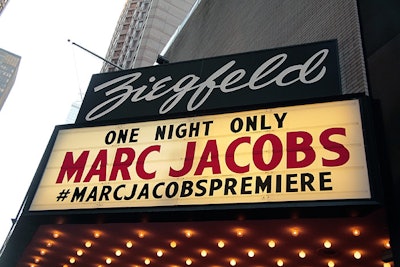
For the first time in recent memory, Marc Jacobs moved his September 17 spring show to a non-Armory venue. Staged at Ziegfeld Theatre, the performance-cum-fashion show (the event hashtag was #MarcJacobsPremiere) had signage that attracted hoards of fans and bystanders. With the Ziegfeld as the venue, the whole show took on a cinematic spirit, with branded popcorn and fountain drink containers, and a customized Playbill for each guest.
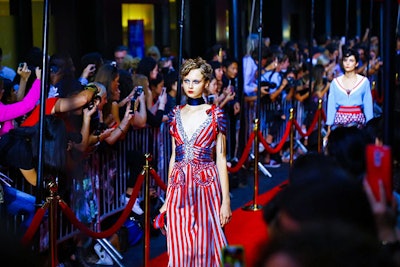
What guests thought was a straightforward red carpet for V.I.P.s turned out, much to their delight, to be the starting point of the show as models walked into the Ziegfeld after emerging from a stage door and posing on a step-and-repeat. Translation: nearly every passerby who stopped to watch the show got a (standing) front-row perch.
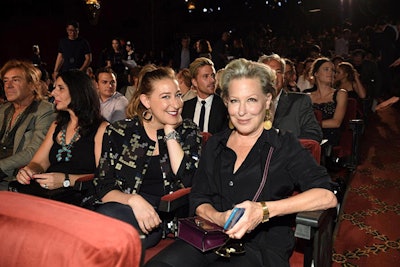
Inside the Ziegfeld, guests took their seats in the theater's traditional format seats. Bette Midler, with daughter Sophie in tow, was placed in aisle seats—the show's equivalent of front-row seating.
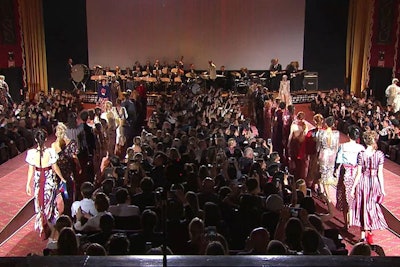
To accommodate a runway in the aisles, several dozen seats were removed from complete rows. Bandleader and trumpet player Brian Newman led a group of on-stage musicians in a rendition of the New York Dolls' "Trash."
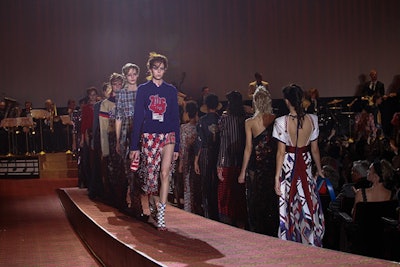
The slightly elevated runway inside the KCD-produced show allowed guests, no matter their seat, to get an optimal view of the looks. Models, once inside the Ziegfeld's bottom-floor lobby, rode the escalators to the second-floor concession area, then into the actual theater.


